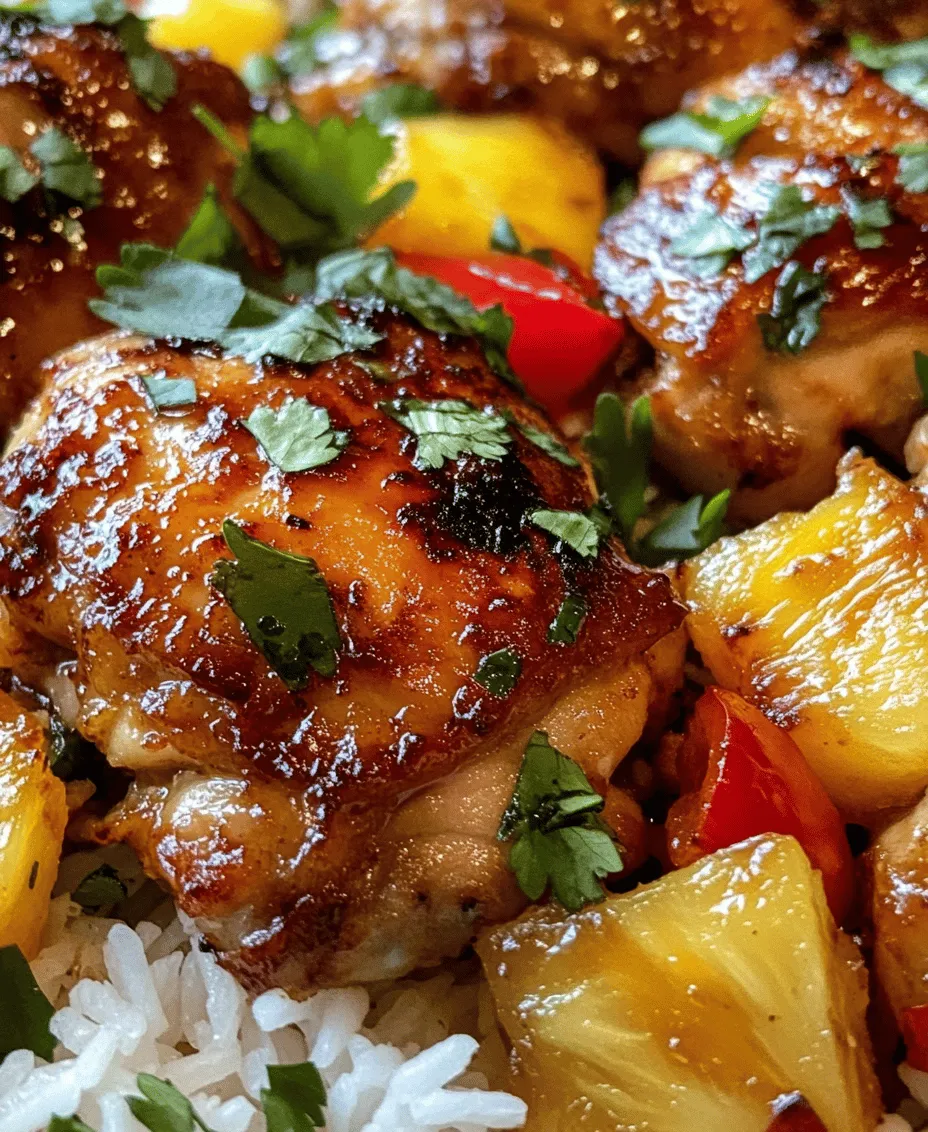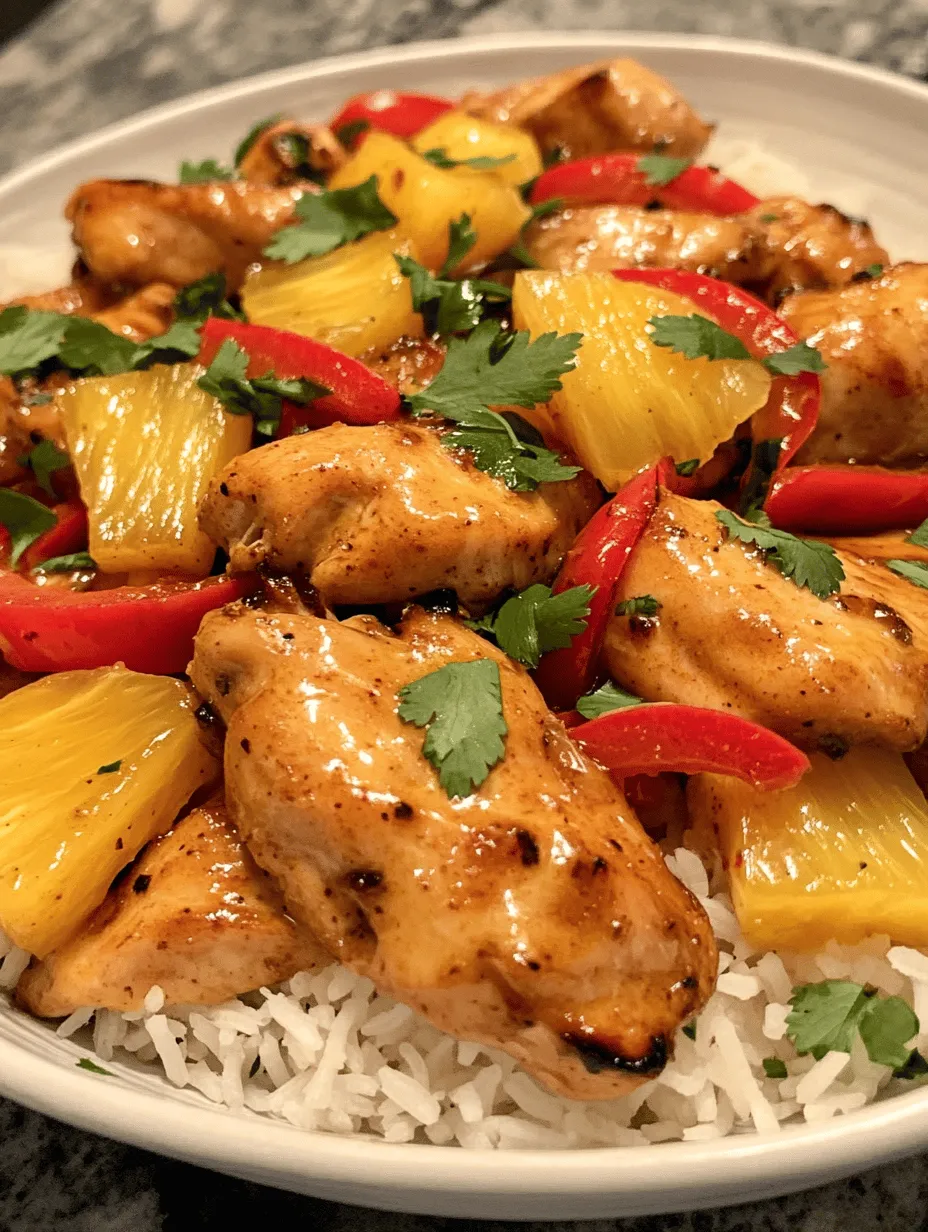Introduction
Thai cuisine is celebrated worldwide for its vibrant flavors, aromatic spices, and a harmonious balance of sweet, sour, salty, and spicy elements. Each dish tells a story, often invoking the rich cultural heritage of Thailand, where fresh ingredients and bold flavors take center stage. Among the many culinary treasures Thailand has to offer, Sweet & Spicy Thai Chicken stands out as a perfect fusion dish that embodies the essence of this delectable cuisine.
This dish is not only a celebration of flavors but also a testament to the versatility of Thai cooking. The combination of succulent chicken thighs, juicy pineapple, and a medley of spices creates a mouthwatering experience that tantalizes the taste buds. With its remarkable balance of sweetness from the pineapple and honey, along with the heat from sriracha, Sweet & Spicy Thai Chicken is ideal for quick weeknight dinners or entertaining guests who appreciate an adventurous palate.
In this article, we will delve into the intricacies of this delightful recipe, exploring the key components of Thai flavors and examining the essential ingredients that make this dish a standout. We will also walk through the preparation steps, ensuring that you can recreate this culinary masterpiece in your own kitchen.
Understanding Thai Flavors
To truly appreciate Sweet & Spicy Thai Chicken, it is essential to understand the fundamental flavors that define Thai cuisine. Thai cooking is rooted in the concept of balance, where each dish harmonizes the four primary tastes: sweet, sour, salty, and spicy. This balance is achieved through the careful selection and combination of ingredients, resulting in dishes that are both complex and satisfying.
Key Components of Thai Cuisine
1. Sweetness: Often derived from ingredients such as palm sugar, honey, or fruits like pineapple, sweetness plays a crucial role in creating a well-rounded flavor profile.
2. Sourness: Ingredients like lime juice, tamarind, and vinegar introduce a refreshing tang that brightens the dish and balances the sweetness.
3. Saltiness: Soy sauce and fish sauce are commonly used to impart a savory depth of flavor, enhancing the overall taste experience.
4. Spiciness: From fresh chilies to chili pastes like sriracha, heat is a defining characteristic of Thai cuisine, adding excitement to each bite.
The interplay of these flavors is what sets Thai dishes apart from others, making them unique and incredibly satisfying.
Common Ingredients Used in Thai Cooking
Thai cuisine utilizes a variety of fresh herbs, spices, and ingredients to create its signature flavors. Some of the most commonly used ingredients include:
– Cilantro: Adds a fresh, aromatic quality.
– Lemongrass: Provides a citrusy note.
– Galangal: Similar to ginger, it adds an earthy flavor.
– Thai basil: Offers a sweet, anise-like flavor.
– Chilies: Varying in heat, they add spiciness to dishes.
By incorporating these ingredients, Thai cooking achieves its characteristic depth and complexity, making each dish a sensory delight.
Ingredient Breakdown
Now that we have a foundational understanding of Thai flavors, let’s take a closer look at the specific ingredients used in our Sweet & Spicy Thai Chicken recipe. Each component contributes to the overall taste and texture, creating a beautifully balanced dish.
Boneless Chicken Thighs
For this recipe, boneless chicken thighs are the star protein. While chicken breasts are often considered the go-to option for many dishes, thighs offer several advantages. They are juicier and more flavorful, providing a tender texture that holds up well against the bold spices. Chicken thighs also have a higher fat content, which not only enhances the flavor but also helps keep the meat moist during cooking.
Vegetable Oil
When it comes to cooking at high temperatures, the choice of oil is crucial. Vegetable oil, with its high smoke point, is ideal for stir-frying the chicken and vegetables without burning. Alternatively, oils like canola or peanut oil can also be used, each imparting a subtle flavor while ensuring that the dish cooks evenly.
Garlic and Ginger
Garlic and ginger are essential aromatics in Thai cooking, providing depth and warmth to the dish. Garlic adds a pungent, savory flavor, while ginger contributes a fresh, spicy note that complements the sweetness of the pineapple and honey. Together, they create a fragrant base that enhances the overall taste of Sweet & Spicy Thai Chicken.
Red Bell Pepper
Adding color and crunch, red bell peppers are not only visually appealing but also nutritious. They are rich in vitamins A and C, providing a natural sweetness that pairs beautifully with the other ingredients. When sautéed, red bell peppers become tender while retaining their vibrant flavor, making them a perfect addition to our dish.
Pineapple
Pineapple is a key ingredient in Sweet & Spicy Thai Chicken, bringing a burst of sweetness and acidity to the dish. The natural sugars in pineapple caramelize during cooking, enhancing the overall flavor profile. Whether you choose to use fresh pineapple or canned pineapple chunks, both options work well. Fresh pineapple offers a juicier texture, while canned pineapple is often more convenient.
Soy Sauce
Soy sauce is another essential component that adds depth and umami to the dish. There are various types of soy sauce, including light, dark, and tamari. For this recipe, a light soy sauce is recommended, as it provides a saltier flavor without overpowering the other ingredients. If you prefer a gluten-free option, tamari is an excellent alternative.
Honey
Honey serves as a natural sweetener, balancing the heat from the sriracha and enhancing the overall flavor of the dish. Its viscosity helps bind the sauce ingredients together, creating a luscious glaze that coats the chicken and vegetables beautifully. Additionally, honey offers health benefits, such as antioxidants and anti-inflammatory properties.
Sriracha
Sriracha is a popular Thai hot sauce that adds a delightful kick to the dish. Its perfect blend of heat and sweetness allows you to adjust the spice level to suit your taste. If you prefer a milder flavor, you can reduce the amount of sriracha, or for those who enjoy extra heat, feel free to add more. Alternatively, other hot sauces or chili pastes can be used as substitutes, depending on your preference.
Rice Vinegar
Rice vinegar is used to balance the acidity in the sauce, enhancing the overall flavor of Sweet & Spicy Thai Chicken. Its mild, slightly sweet taste complements the other ingredients without being overpowering. If you don’t have rice vinegar on hand, apple cider vinegar can serve as a suitable substitute, although it may alter the flavor slightly.
Cornstarch
To achieve the desired consistency of the sauce, cornstarch is used as a thickening agent. When mixed with water and added to the sauce, cornstarch helps create a glossy finish that clings to the chicken and vegetables. If you’re looking for alternatives, arrowroot powder or tapioca starch can be used similarly.
Fresh Cilantro
Fresh cilantro adds an aromatic touch and a burst of freshness to the dish. As a garnish, it enhances the visual appeal while providing a bright, herbal flavor that complements the sweetness and spice of the chicken. If you’re not a fan of cilantro, you can omit it or replace it with fresh basil for a different flavor profile.
Jasmine Rice
To serve alongside Sweet & Spicy Thai Chicken, jasmine rice is the perfect pairing. Its fragrant aroma and slightly sticky texture make it an ideal accompaniment, soaking up the flavorful sauce and balancing the dish. When cooked properly, jasmine rice becomes fluffy and light, providing a satisfying base for the chicken.
Preparation Steps for Sweet & Spicy Thai Chicken
Now that we have an understanding of the essential ingredients, it’s time to dive into the preparation steps for creating this delicious Sweet & Spicy Thai Chicken. The process is straightforward and can be completed in under 30 minutes, making it an excellent choice for a busy weeknight dinner.
1. Marinate the Chicken: Begin by cutting the boneless chicken thighs into bite-sized pieces. In a mixing bowl, combine the chicken with soy sauce, honey, and sriracha. Allow it to marinate for at least 15 minutes—this step infuses the chicken with flavor and helps tenderize the meat.
2. Prepare the Vegetables: While the chicken is marinating, wash and slice the red bell pepper into thin strips. If using fresh pineapple, cut it into bite-sized chunks. Set aside the prepared vegetables for later use.
3. Make the Sauce: In a small bowl, mix together rice vinegar and cornstarch to create a slurry. This will be added to the sauce later for thickening.
4. Cook the Chicken: Heat vegetable oil in a large skillet or wok over medium-high heat. Once the oil is hot, add the marinated chicken to the pan. Sauté the chicken for about 5–7 minutes or until it is cooked through and begins to brown slightly.
5. Add Aromatics: Once the chicken is cooked, add minced garlic and ginger to the skillet. Stir-fry for an additional minute until fragrant, being careful not to burn the garlic.
6. Incorporate Vegetables: Add the sliced red bell pepper and pineapple chunks to the skillet. Stir-fry for another 3–4 minutes, allowing the vegetables to soften slightly while still maintaining their texture.
7. Thicken the Sauce: Pour the prepared cornstarch slurry into the skillet, stirring continuously to combine. The sauce will begin to thicken as it heats up. Continue cooking for another minute until the sauce coats the chicken and vegetables nicely.
8. Garnish and Serve: Remove the skillet from heat and garnish the Sweet & Spicy Thai Chicken with freshly chopped cilantro. Serve hot over a bed of fluffy jasmine rice, allowing the rice to soak up the delicious sauce.
By following these steps, you will create a dish that is not only visually stunning but also bursting with flavor. The Sweet & Spicy Thai Chicken is sure to impress your family and friends, making it a go-to recipe for any occasion. Enjoy the journey of cooking this delightful dish, and stay tuned for the next part, where we will explore additional tips and tricks to elevate your Thai cooking skills.




